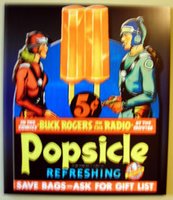Sounds rather like a character from a comic book or an old radio serial.
Fantastic problems of science and the near future have been the stuff of fertile imaginations for well over a century. Often such problems have been romanticized as science fiction stories, police mysteries, and action adventure tales in wide variety of forms. Pulp magazines, live radio broadcasts, and comic books would take us on regularly scheduled journeys to distant lands and exciting dangers. The movies would extend these departures with sights to amaze us, and as television grew out of its infant years, the journeys would follow us into our living rooms, first in black and white, and then in living color.
Outlets for our fascination with the fantastic have become an integral part of popular culture. In the last 70 years, the creators and marketeers of our entertainment have left in their wake a trail of memorabilia that most of us probably discarded as we moved on to newer locations.
A few people, however, have not only kept the train schedules for those old journeys, they've kept the trains running.
 On a recent trip to Baltimore, I was fortunate enough to have a few hours to visit Geppi's Entertainment Museum. Located at Camden Yards, Geppi's is a unique museum dedicated to preserving pop-culture expression as made manifest in print, audio, video, and three-dimensional forms. Geppi's opened its doors to the public on September 8th, and is the product of owner Steve Geppi's career as a comic-book and pop-culture memoribilia collector and dealer.
On a recent trip to Baltimore, I was fortunate enough to have a few hours to visit Geppi's Entertainment Museum. Located at Camden Yards, Geppi's is a unique museum dedicated to preserving pop-culture expression as made manifest in print, audio, video, and three-dimensional forms. Geppi's opened its doors to the public on September 8th, and is the product of owner Steve Geppi's career as a comic-book and pop-culture memoribilia collector and dealer. This is no ordinary trip down memory lane that a person might take as easily with a web browser and few hours on eBay. From the moment you enter the ground-level doors to the Sports Legend Museum, your eye is drawn to the fact that something special is located one floor above you. Colorful doors lead to a stairwell adorned with enlargements of memorabilia that beckon to anyone who was or wished they were a child of the 1930's and 1940's. Whether you wished you were part of Roy Rogers' posse or one of Buck Rogers' faithful space followers that listened with anticipation for each week's exciting radio broadcast, you are led up the stairs to the second floor by images of yesteryear that are irresistable.
This is no ordinary trip down memory lane that a person might take as easily with a web browser and few hours on eBay. From the moment you enter the ground-level doors to the Sports Legend Museum, your eye is drawn to the fact that something special is located one floor above you. Colorful doors lead to a stairwell adorned with enlargements of memorabilia that beckon to anyone who was or wished they were a child of the 1930's and 1940's. Whether you wished you were part of Roy Rogers' posse or one of Buck Rogers' faithful space followers that listened with anticipation for each week's exciting radio broadcast, you are led up the stairs to the second floor by images of yesteryear that are irresistable. Upon entering the museum you are immediately surrounded by larger than life posters of movie serials that run from floor to almost cathedral ceiling, but that is only a tease. After paying your $10 admission (a bargain), you pass through into a beautifully designed balance of brick, wood, and light which is arranged in a massive hallway, adorned with framed objects. To simply call them posters would be inaccurate. Upon closer inspection, it becomes obvious by the script indexes painted into the walls by each object that before you is mounted many dozens if not hundreds of original six-sheet lobby prints from original RKO releases, or personal line art and scripts from such names as Siegel and Schuster. You're not just walking among a collection from someone who has been successful in life and is spending the equivalent of the Kansas domestic product preserving it (Steve Geppi has likely spent on framing alone more than you'll earn in the first 10 years of your career). You're walking into a gallery exhibition that only comes along once or twice in a lifetime.
Upon entering the museum you are immediately surrounded by larger than life posters of movie serials that run from floor to almost cathedral ceiling, but that is only a tease. After paying your $10 admission (a bargain), you pass through into a beautifully designed balance of brick, wood, and light which is arranged in a massive hallway, adorned with framed objects. To simply call them posters would be inaccurate. Upon closer inspection, it becomes obvious by the script indexes painted into the walls by each object that before you is mounted many dozens if not hundreds of original six-sheet lobby prints from original RKO releases, or personal line art and scripts from such names as Siegel and Schuster. You're not just walking among a collection from someone who has been successful in life and is spending the equivalent of the Kansas domestic product preserving it (Steve Geppi has likely spent on framing alone more than you'll earn in the first 10 years of your career). You're walking into a gallery exhibition that only comes along once or twice in a lifetime.Geppi's Entertainment Museum is currently spread out into different rooms on the 2nd floor (with an option to fill out the 3rd floor) which represent different eras in the 19th and 20th centuries. One exception to this is the massive comic book room, aptly labeled "A Study In Four Colors". Every comic book is protected by layers of glass and low light. Even in these display constraints, it is clear that many of these comic books are in excellent condition. (I would challenge the reader to discover just how many original copies of Action Comics #1 dot the museum.) Each comic book shows a slice of history. Some are seminal moments in comic book storytelling. Others are snapshots in a mirror, showing larger events in the world that comic books often reflect.
(To Be Continued...)
